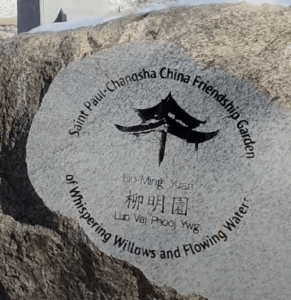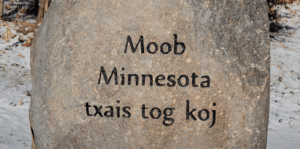Last updated: 3/8/2022
 Response to Councilman Dai Thao’s December 14, 2021 Statements and Recommendations About the Use of “Moob,” “Hmoob,” or “Hmong” for Inscribing on a Rock at the Saint Paul-Changsha China Friendship Garden
Response to Councilman Dai Thao’s December 14, 2021 Statements and Recommendations About the Use of “Moob,” “Hmoob,” or “Hmong” for Inscribing on a Rock at the Saint Paul-Changsha China Friendship Garden
Purpose & Disclaimer:
For the last several months, there has been ongoing discussion or debate on whether it is appropriate to use the term “Moob” on a stone at the Saint Paul-Changsha China Friendship Garden. On December 14, 2021, Councilman Dai Thao, via an email, made several statements and recommendations regarding the issue. This posting is a response to his email.
As a people, we only want the best for all white and green Hmong/Mong, and we all only want to be treated with respect and dignity. The responses and clarifications attempt to provide transparency, identify differences and commonalities, and recommend solutions.
For consistency, so there would be less confusion, the terms “white and green Hmong/Mong” or variations of it such as “Green/Blue Hmong and White Hmong” have been used throughout this discussion since these terms were used by The Minnesota China Friendship Garden Society and Councilman Dai Thao. However, in the Hmong community, the two dialects are actually referred to as “Mong Leng” and “Mong Der.” Mong Leng is referring to those whose dialect is the “green” or “blue” dialect, while Mong Der is referring to those whose dialect is the “white” dialect. But to refer to the name of our people, inclusive of both groups, it would be just either Hmong or Mong in English and “Hmoob” or “Moob” in our language.
 Councilman Dai Thao:
Councilman Dai Thao:
“… It is the first (welcoming) stone that contains “Moob” that is not inclusive – creating the problem because it is written in the green dialect. The white dialect would write it as “Hmoob” and a neutral way of it would be written as “Hmong”. Hmong is the inclusive spelling because it is not dialect related.”
Response:
Councilman Dai Thao’s statement about the words “Moob” and “Hmong” is imbalanced and fundamentally untrue. The term “Moob” is inclusive; it refers to white and green Hmong/Mong people. In English, the equivalent word to “Hmong” is “Mong.”
He acknowledged that two main dialects are being written and spoken in our community – the white and green dialects. As such, it must be recognized that just as “Hmoob” is an acceptable term for referring to our people in the white dialect, “Moob” is the equivalent term for referring to our people in the green dialect. Therefore, “Moob” is an inclusive word. In English, “Hmong” has become more commonly used because of discrimination, but “Mong” is the equivalent. There is currently no global standard way of writing the name of our people.
If “Hmoob and Moob” or “Hmong and Mong” will not be recognized and be permitted to be used interchangeably, then a new term acceptable by both white and green Hmong/Mong should be used. Commissioned by General Vang Pao, the Hmong Language Research Committee came up with the term “Mhong,”which was even used by General Vang Pao as early as the 1970s. However, both green and white Hmong/mong groups have not acknowledged this term. Perhaps, it is time to revisit adopting “Mhong” as the official term to refer to our people in English as a solution.
In summary, the issue is not just what Councilman Dai Thao had put forth that “Moob” is not inclusive. The issue is simply an age-old struggle between white and green Hmong/Mong of one group (White Hmong/Mong) wanting to dominate the other (Green Hmong/Mong). It is the age-old struggle of societies across time of one group or nation wanting to push their agenda over another group or nation. Councilman Dai Thao and those who support his position are attempting to push “Hmoob” and “Hmong” forward while erasing “Moob” and “Mong.” That is what is transpiring in this debate; it has nothing to do with the lack of inclusiveness.
Councilman Dai Thao:
“According to the Hmong 18 Council, they want to be apart of the process but the Advisory Committee never involved them on the stones project. There was never community engagement. The Hmong 18 Council felt the Advisory Committee only invited the Hmong 18 Council and community leaders to the ribbon cutting to use their presence to create the illusion of support. When 18 Council saw “Moob” inscribed on the welcoming stone (first stone), the 18 Council members present talked among themselves that there would be an issue because it was not inclusive. The inclusive spelling would be the English spelling “Hmong” which encompasses all Hmong dialects.”
Response:
Councilman Dai Thao stated that the Advisory Committee never involved the Hmong 18 Council and that there was never community engagement, however, we’ve now learned that there was community engagement and there was a member of the Hmong 18 Council among the Hmong Advisory Committee. The Hmong 18 Council representative was Song Neng Her who is the current VP of the Hmong 18 Council. All of these facts are contrary to Councilman Dai Thao’s statement.
The Hmong Heritage Wall (Hmoob Puav Pheej) label has been agreed to be written in the white Hmong/Mong dialect in the same garden. Councilman Dai Thao and the Hmong 18 Council did not oppose it. They did not come out to say, “Oh, the term Hmoob is not inclusive, and therefore, it must be changed to Hmong,” as they are doing to the use of the green Hmong/Mong term “Moob.”
To single out and take offense and exception to the use of the green Hmong/Mong term “Moob” is simply an attempt to dominate and seal the lips of the green Hmong/Mong dialect speakers or Mong Leng. This is an attempt to violate a fundamental human right of the Mong Leng – the right to speak and write in the way that one deems fit for one’s people.
Inscribing “Moob” on the stone is not an issue of not being inclusive, as claimed by Councilman Dai and the 18 Council. The word “Moob” is the equivalent of “Hmoob.” Each of these terms refers to both green and white Hmong/Mong, which has been the case since time immemorial in our community. Councilman Dai Thao is attempting to use his platform as an elected official to misinform our non-Hmong audience and those who are unfamiliar with our people’s language.
Councilman Dai Thao:
“After the ribbon cutting, the complains started coming in. Mr. Thaying then called 18 Council President to discuss the problem and asked for advice. The President shared his concerns at that time, and recommended Mr. Thaying fix the problem to avoid further problem. Mr. Thaying informed the 18 Council President it would cost $500 to fix. Mr. President then said, $500 is not a lot, I am sure everyone can give a little to come up with the money.”
Response:
Councilman Dai Thao wrote that this communication had occurred between the President of the Hmong 18 Council of Minnesota and Mr. Thaying Heu. However, Mr. Thaying Heu verified via a phone call on 2/14/2022 that he never had such a conversation with the President of the Hmong 18 Council.
Councilman Dai Thao Recommendations:
1. “The Advisory Committee should be in compliance to create a transparent and inclusive forum for community engagement. They must go back and work with community members, Hmong 18 Council and stakeholders to be inclusive and transparent to resolve the problem. If the advisory committee fails to be in compliance then they should be dissolved by the City and a new advisory committee be formed.”
Response:
Inherent in this recommendation is that the Advisory Committee has not created a transparent and inclusive forum for community engagement. However, it raises the question of whether the Advisory Committee had acted out of compliance or has it worked within the scope and directions that have been given them.
We understand that the Advisory Committee, which is made up of an equal number of white and green Hmong/Mong members, had acted within the scope given them. This needs to be clarified, which will inform whether there is a need to re-engage the community. If the Advisory Committee had, indeed, acted out of compliance, then it makes sense to re-engage the community; but if they have worked within the boundaries that they’ve been authorized, then there is no need for more community engagement forums and the creation of a new advisory committee.
2. “The Advisory Committee to be trained on their role, responsibilities, and transparency working with the community. This is critical because we want to mitigate problems with future phases of the project. Training should be on an annual basis or part of an onboarding process.”
Response:
Training is always welcome, but whether the real issue is a lack of training for the Advisory Committee or something else should be asked.
Based on the rationale that Councilman Dai Thao had put forth with regards to the terms “Hmong” and “Hmoob” versus “Moob,” he has only demonstrated that he wants to shut out the green Hmong/Mong speakers’ way of referring to our people. If anyone needs training, Councilman Dai Thao needs cultural sensitivity training and what it requires to be a public servant.
Fundamentally, a public servant must serve all white and green Hmong/Mong community members and others. What’s happened here is that Councilman Dai Thao is attempting to deliberately shut out the green Mong with his false notion about what “Moob” and “Hmong” represent. Contrary to his definition of “Moob,” this word is inclusive and refers to all green and white Mong in the green Mong dialect, and it is the equivalent of “Hmoob” in the white Mong dialect. It is the green Mong’s way of writing and pronouncing the name of our people.
The Advisory Committee had acted unbiasedly to ensure that both white and green Hmong/Mong dialects were reflected in the inscriptions. There is an equal number of stones written in each dialect.
3. “The Ward 1 and 6 offices should get regular or monthly (whichever is feasible) debrief on the project going forward to help prevent problems in the future.”
Response:
Getting regular debriefs should have been established and maintained from the start. The lack of regular debriefs and updates has been due to the failure of Councilman Dai Thao and others to ensure that it occurs.
Recommended Solutions
- Keep the welcoming stone with the word “Moob” just as it was designed.
- Require Councilman Dai Thao to go through cultural sensitivity training towards green Hmong/Mong or Mong Leng.
- Apologize to them for his misconduct; he must resign from office.
Information about “Moob”
Watch from 46:42 – 52:05
The Truth Behind the Name Mong & Hmong